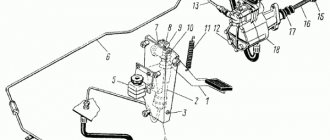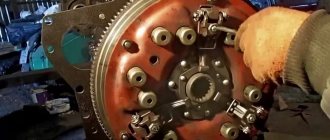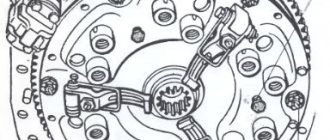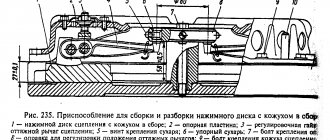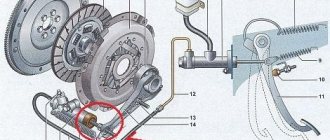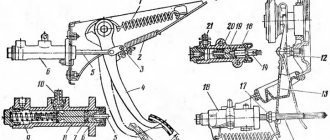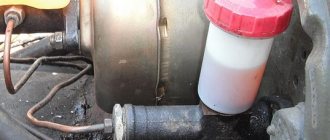What is the KamAZ-5320 PGU device? This question interests many beginners. This abbreviation may confuse an ignorant person. In fact, the PGU is a pneumatic hydraulic power steering. Let's look at the features of this device, its operating principle and types of maintenance, including repairs.
- 1 – spherical nut with lock nut.
- 2 – piston pusher of the clutch deactivator.
- 3 – protective cover.
- 4 – clutch release piston.
- 5 – back part of the frame.
- 6 – complex seal.
- 7 – follower piston.
- 8 – bypass valve with cap.
- 9 – diaphragm.
- 10 – inlet valve.
- 11 – graduation analogue.
- 12 – pneumatic type piston.
- 13 – drain plug (for condensate).
- 14 – front part of the body.
- “A” – supply of working fluid.
- “B” – supply of compressed air.
Purpose and device
A truck is a fairly massive and large-sized vehicle. Controlling it requires remarkable physical strength and endurance. The KamAZ-5320 PGU device makes it easier to adjust the vehicle. This is a small but useful device. It makes it possible not only to simplify the driver’s work, but also increases work productivity.
The node in question consists of the following elements:
- Piston pusher and adjusting nut.
- Pneumatic and hydraulic piston.
- Spring mechanism, gearbox with cover and valve.
- Diaphragm seats, control screw.
- Bypass valve and piston follower.
Peculiarities
The amplifier housing system consists of two elements. The front part is made of aluminum, and the rear part is made of cast iron. A special gasket is provided between the parts, which acts as a seal and diaphragm. The follower mechanism automatically regulates the change in air pressure on the pneumatic piston. This device also includes a sealing collar, springs with diaphragms, as well as inlet and outlet valves.
Operating principle
When the clutch pedal is pressed under fluid pressure, the KamAZ-5320 PGU device presses on the rod and piston of the follower, after which the structure, together with the diaphragm, moves until the intake valve opens. The air mixture from the vehicle's pneumatic system is then supplied to the pneumatic piston. As a result, the forces of both elements are summed up, which allows you to retract the fork and disengage the clutch.
After the foot is removed from the clutch pedal, the pressure of the supply main fluid drops to zero. As a result, the load on the hydraulic pistons of the actuator and follower mechanism is reduced. For this reason, the hydraulic piston begins to move in the opposite direction, closing the inlet valve and blocking the flow of pressure from the receiver. The pressure spring, acting on the follower piston, moves it to its original position. The air initially reacting with the pneumatic piston is released into the atmosphere. The rod with both pistons returns to its initial position.
How to maximize the service life of a node?
In order for the Zil 130 truck to need repair as little as possible, it is necessary to operate it in compliance with several simple rules. You can move away in both first and second gear. You should try to release the clutch pedal as smoothly as possible. When parked with the engine running, do not keep your foot on the pedal. In addition, the pedals should not be left partially pressed while driving. This leads to premature wear and early failure of the entire assembly. You should not drive or change gears at high engine speeds. The adjustments described above must be made periodically. Following these simple rules will help maintain the functionality of the unit for as long as possible, as well as eliminate unexpected breakdowns.
Production
The KamAZ-5320 PGU device is suitable for many model modifications of this manufacturer. Most old and new tractors, dump trucks, and military variants are equipped with pneumatic-hydraulic power steering. Modern modifications produced by various companies have the following designations:
- Spare parts for KamAZ (PGU) manufactured by KamAZ OJSC (catalog number 5320) with vertical placement of the tracking device. The device above the cylinder body is used on variations under the index 4310, 5320, 4318 and some others.
- WABCO. CCGT units under this brand are manufactured in the USA and are distinguished by their reliability and compact dimensions. This equipment is equipped with a system for monitoring the condition of the linings, the level of wear of which can be determined without dismantling the power unit. Most trucks with a 154 series transmission are equipped with this type of air-hydraulic equipment.
- Pneumatic hydraulic clutch booster "VABKO" for models with ZF type gearbox.
- Analogues produced at a plant in Ukraine (Volchansk) or Turkey (Yumak).
In terms of choosing an amplifier, experts recommend purchasing the same brand and model that was originally installed on the machine. This will ensure the most correct interaction between the amplifier and the clutch mechanism. Before changing the unit to a new variation, consult a specialist.
Service
To maintain the operating condition of the unit, carry out the following work:
- Visual inspection to detect visible air and fluid leaks.
- Tightening the fixing bolts.
- Adjust the free play of the pusher using a spherical nut.
- Adding working fluid to the system tank.
It is worth noting that when adjusting the KamAZ-5320 PGU of the Wabco modification, the wear of the clutch linings is easily visible on a special indicator extended under the influence of the piston.
Adjustments
If no serious damage has been found and replacement of structural elements or bleeding of the clutch is not required, you can make adjustments to a number of parts. This will not only extend the life of the clutch assembly, but also improve the operation of the vehicle.
Free play adjustment
The free play of the clutch pedal should not exceed 6-15 mm. You can measure the value using a standard ruler. To do this, you will need to rest it on the floor of the cabin.
If the above values are found to be exceeded, it is recommended to adjust the gap formed between the assembly pusher and the piston. To perform the procedure correctly, you must pull the pedal up all the way, and then:
- Unscrew the nut and loosen it using a wrench.
- Rotate the finger that is responsible for connecting the lever with the eye, which is located at the top.
- Move the pedal from the top position until it touches the piston by an amount of 6-15 mm.
Next, all that remains is to tighten the crown and check the reliability of the fixation.
Adjusting clutch free play
The bearing coupling is one of the important elements in the assembly. The free play should not be more than 4 mm in order to ensure comfortable and quick engagement of the clutch. You can check whether this requirement is met by moving the lever.
To adjust, it is enough to fix the spherical nut of the pneumatic booster pusher and connect the spring to the lever structure.
Clutch pushrod adjustment
The full stroke must be more than 25 mm. Only thanks to this parameter is it possible to ensure complete disengagement of the clutch structure. If the size is smaller, this will not be possible, which will lead to rapid failure of the unit.
You can check the full stroke by pressing the clutch pedal all the way. If everything is in order, then no problems in the form of extraneous sounds or difficulties in performing the action will arise. If the value is not enough, it is recommended to check the liquid level inside the tank and also adjust the free play of the pedal.
Bleeding the MAZ clutch is undoubtedly a difficult procedure, but it can be done independently with an assistant or support. At the same time, it is not at all necessary to contact specialized centers if the car owner knows its structure and is able to solve the problem following the instructions.
Adjusting and bleeding the MAZ clutch is a necessary procedure that is sometimes necessary for the quality operation of the vehicle. This is explained by the fact that the unit experiences serious loads, and therefore, when changing the gear, extraneous noise or even crackling may appear.
In any case, if a malfunction is detected, it is recommended to diagnose the condition of the unit as quickly as possible, as well as adjust it or completely bleed the clutch structure. How to bleed the clutch on a MAZ? This issue needs to be addressed in detail.
Disassembly
This procedure, if necessary, is performed in the following order:
- The back of the body is clamped in a vice.
- The bolts are unscrewed. Remove the washers and cover.
- The valve is removed from the body part.
- The front frame is dismantled along with the pneumatic piston and its membrane.
- The following are removed: the diaphragm, the follower piston, the retaining ring, the clutch release element and the seal housing.
- The bypass valve mechanism and the hatch with the outlet seal are removed.
- The frame is removed from the yews.
- The thrust ring of the rear part of the housing is dismantled.
- The valve stem is freed from all cones, washers and seats.
- The follower piston is removed (you must first remove the stopper and other related elements).
- The pneumatic piston, cuff and retaining ring are removed from the front part of the housing.
- Then all parts are washed in gasoline (kerosene), sprayed with compressed air and go through the defect detection stage.
Breakdown options
Any mechanism has its own resource, therefore, breakdowns are inevitable. Some car parts are replaced as planned after traveling a certain mileage. The clutch is a specific “organ” of the car that is constantly used. Moreover, the service life directly depends on the conscientious and careful attitude of the driver. If you squeeze the accelerator carelessly, throw it, or don’t press it all the way, you can quickly “burn the clutch” or damage the PSU. Technically, these problems can be reduced to several points.
- The rubber ring or cuff swells, and accordingly, the PSU follower piston jams. A jammed part, designed to be in constant motion, naturally stops in one position, therefore slowing down the operation of the entire system.
- A damaged intake valve produces too little compressed air. Air flows help the system create the necessary pressure, the absence of which leads to breakdown.
- Air inside the hydraulic drive disrupts circulation. The driver may feel an excessive amount of air in the form of sagging of the clutch pedal.
Due to the fact that the basis of the operation of the CCGT is musculoskeletal moments occurring under high pressure, subsidence of soft rings, cuffs, lack of air or its presence in the wrong places lead to breakdowns of the entire system, disrupting the operation of the CCGT.
PGU KamAZ-5320: malfunctions
Most often, the following problems occur in the node in question:
- The compressed air flow is supplied in insufficient quantities or completely absent. The cause of the malfunction is swelling of the inlet valve of the pneumatic booster.
- Jamming of the follower piston on the pneumatic booster. Most likely, the reason lies in the deformation of the o-ring or cuff.
- There is a “failure” of the pedal, which does not allow the clutch to be completely disengaged. This problem indicates that air has entered the hydraulic drive.
Instructions: How to properly bleed the clutch yourself
Diagnostics and repair of a car clutch involves removing it entirely or partially from the car, disassembling and disconnecting various parts. This causes air to enter the hydraulic system of the control mechanism. Therefore, any master knows that after repairs it is necessary to bleed the car’s clutch, removing excess air from it. When repairing a car clutch on your own, or when symptoms of air entering the system appear, the driver must know how to bleed the clutch on his own.
When is it necessary to bleed the clutch?
As noted above, the clutch bleeding procedure is necessary when the hydraulic system is depressurized, which is most often caused by repair or diagnostic work. At the same time, air can also enter the hydraulic system over time when the machine is used if the connections of the clutch mechanism units have not been tightened properly. In addition, cracks in the pipeline or other malfunctions can cause air to enter the clutch.
There are several symptoms that indicate that the clutch needs to be pumped:
- The car jerks when driving;
- The clutch pedal “beats”;
- The required result is not achieved when squeezing the clutch, only after one and a half or double squeeze.
Driving a car with a faulty clutch is extremely dangerous, both for the driver and for the units. You can bleed the clutch without contacting a service center by following the instructions below.
What is required to bleed the clutch?
The clutch bleeding process can be done in the field or in the garage as it does not require many tools. To bleed the clutch alone you will need:
- New brake fluid;
- Empty container for draining brake fluid from the system;
- Automotive tool set (standard);
- Rubber hose that fits the diameter of the drain fitting;
- A device that allows you to fix the clutch is most often a “gas stop,” but other tools can be used.
Please note: You can do without a clutch locking device if you have a friend who can take on this task.
How to bleed the clutch
Important: Before you begin bleeding, you must adjust the clutch. Bleeding the clutch won't make much sense unless the cylinder piston pusher moves freely.
Before you begin bleeding the clutch, make sure that the brake fluid prepared for use complies with the vehicle manufacturer's recommendations. Using the wrong brake fluid can cause clutch failure due to swelling of the rubber linings.
Clutch bleeding is carried out according to the following plan:
- First, you need to clean the master cylinder reservoir as much as possible so that when adding brake fluid, no dirt, dust or other debris gets into it;
- After this, suitable brake fluid is added to the reservoir so that there is about 2 centimeters of free space from its upper edge;
- Next, from the bypass valve located in the upper part of the pneumatic hydraulic booster, it is necessary to remove the rubber cap and put a prepared rubber hose of a suitable diameter on it;
- You need to pour about 200 milliliters of new brake fluid into an empty container and lower the rubber hose into it;
- Next, the bypass valve is turned back one turn and the assistant is commanded to press the clutch pedal all the way. The squeezing must be done slowly, while ensuring that the hose is in the brake fluid. The release of excess air from the clutch system will be indicated by the appearance of bubbles on the surface of the brake fluid poured into the container. Important: When depressing the clutch, you need to monitor the amount of brake fluid in the reservoir. If its level drops below 3.5 centimeters from the top edge, you need to add more liquid.
- When the clutch pedal is pressed all the way, it is necessary for an assistant to continue to hold it there. At this point you need to tighten the bypass valve. After this you can release the pedal. Then the bypass valve opens again one turn, and the assistant presses the pedal. This procedure should be repeated 3-4 times. If air continues to leave the system for the fourth time, it is necessary to perform it until all of it leaves the clutch;
- After all the air has been released from the clutch, you need to tighten the bypass valve securely, remove the hose and put the cap on the fitting.
If required, after completing the work, you can add brake fluid to the recommended value - from 1.5 to 2 centimeters from the top edge of the reservoir.
Repair of KamAZ-5320 PGU
When troubleshooting the elements of a unit, special attention should be paid to the following points:
- Checking sealing parts. Deformations, swelling and cracks are not allowed on them. If the elasticity of the material is impaired, the element must be replaced.
- Condition of the working surfaces of the cylinders. The internal clearance of the cylinder diameter is monitored, which in fact must comply with the standard. There should be no dents or cracks on the parts.
The CCGT repair kit includes the following KamAZ spare parts:
- Protective cover for rear housing.
- Cone and diaphragm of the gearbox.
- Cuffs for pneumatic and follower piston.
- Bypass valve cap.
- Retaining and sealing rings.
Before installation, it is recommended to treat all parts with Litol type lubricant.
Replacement and installation
To replace the node in question, perform the following manipulations:
- The air is being bled from the KamAZ-5320 CCGT unit.
- The working fluid is drained or the drain is blocked using a plug.
- The clutch spring fork is removed.
- The water and air supply pipes are disconnected from the device.
- The fastening screws to the crankcase are unscrewed, after which the unit is dismantled.
After replacing deformed and unusable elements, the system is checked for leaks in the hydraulic and pneumatic parts. Assembly is carried out as follows:
- Align all the fixing holes with the sockets in the crankcase, after which the amplifier is secured using a pair of bolts with spring washers.
- The hydraulic hose and air line are connected.
- The release spring mechanism of the clutch release fork is mounted.
- Brake fluid is poured into the compensation reservoir, after which the hydraulic drive system is pumped.
- Re-check the tightness of the connections for leakage of working fluid.
- If necessary, adjust the size of the gap between the end part of the cover and the travel limiter of the gear divider activator.
Bleeding the clutch
Many MAZ owners are well aware of the problems that may arise during the operation of the car. Among such problems, air getting inside the hydraulic element of the clutch assembly is quite common.
Among the reasons leading to such trouble are:
- pipe damage;
- loose tightening of certain parts.
There is a sequence of actions that can be used to bleed the MAZ clutch and restore or even improve the performance of the entire unit.
Materials and tools
Before you begin, you should prepare the necessary tools and materials. The main equipment that may be required during repairs includes:
- Brake fluid. It is recommended to be as careful as possible when using this liquid, as its composition is poisonous.
- A set of tools that every driver has.
- A container in which you will need to pour out the brake fluid.
- Hose. The diameter of the hose must match the diameter of the drain hole.
You will also need to find an assistant, since it will be almost impossible to cope with the task alone. In addition, it will be much more convenient to pump the clutch with two or even three people. If you cannot find an assistant, then it is recommended to find a suitable device with which you can fix the clutch pedal. Such a device can be a rail or, for example, a stick made of wood or metal.
Schematic diagram of connection and placement of node elements
The operating principle of the KamAZ-5320 PGU is easier to understand by studying the diagram below with explanations.
- a – standard diagram of interaction of drive parts.
- b – location and fixation of node elements.
- 1 – clutch pedal.
- 2 – main cylinder.
- 3 – cylindrical part of the pneumatic amplifier.
- 4 – follower mechanism of the pneumatic part.
- 5 – air duct.
- 6 – main hydraulic cylinder.
- 7 – release clutch with bearing.
- 8 – lever.
- 9 – rod.
- 10 – drive hoses and pipes.
The unit in question has a fairly clear and simple structure. Nevertheless, its role when driving a truck is very significant. The use of a PSU can significantly facilitate machine control and increase the efficiency of the vehicle.
Bleeding the clutch
Many MAZ owners are well aware of the problems that may arise during the operation of the car. Among such problems, air getting inside the hydraulic element of the clutch assembly is quite common.
Among the reasons leading to such trouble are:
- pipe damage;
- loose tightening of certain parts.
There is a sequence of actions that can be used to bleed the MAZ clutch and restore or even improve the performance of the entire unit.
Materials and tools
Before you begin, you should prepare the necessary tools and materials. The main equipment that may be required during repairs includes:
- Brake fluid. It is recommended to be as careful as possible when using this liquid, as its composition is poisonous.
- A set of tools that every driver has.
- A container in which you will need to pour out the brake fluid.
- Hose. The diameter of the hose must match the diameter of the drain hole.
You will also need to find an assistant, since it will be almost impossible to cope with the task alone. In addition, it will be much more convenient to pump the clutch with two or even three people. If you cannot find an assistant, then it is recommended to find a suitable device with which you can fix the clutch pedal. Such a device can be a rail or, for example, a stick made of wood or metal.
Step-by-step instruction
Many people wonder how to upgrade the PGU in MAZ? Removing air and pumping the hydraulic drive is carried out in several stages. Each of them represents the following actions:
- First of all, the car owner will need to remove the plug that is installed on the tank. This is done so that brake fluid can subsequently be poured inside to a level of 1.5 cm above the boundaries of the container lid.
- Next, you need to dismantle the cap located in the place where the bypass valve is located. When the action is completed, you need to connect a hose to the valve head and then insert the other end of this hose into the container where the brake fluid is filled.
- The third step is to unscrew the bypass valve either half a turn or a full turn. Further, the operating principle is simple. The car owner will then need to press the pedal as sharply as possible so that it quickly hits the limiter. This must be done in such a way that the release of air bubbles formed inside the liquid is stopped.
- During the pumping process, you should add liquid inside the tank, while making sure that the volume does not decrease and does not rise above 4 cm to the edge of the upper border of the neck of the container.
- When the pumping is completed, you should screw the bypass valve all the way, without releasing the pedal that is pressed all the way, and also remove the hose and return the cap to its place, fixing its position.
Completion of pumping implies another injection of liquid into the tank in order to achieve the optimal volume and continue operation of the vehicle.
You can evaluate the success of the completed task by how the pusher of the pneumatic amplifier works. If full travel has been achieved, the job has been done correctly. The same can be demonstrated by the liquid inside the main cylinder, which does not contain air and is in the optimal volume during the movement of the car and the operation of the clutch.

